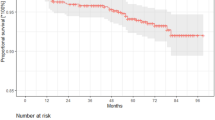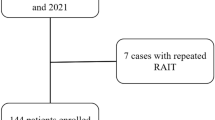Abstract
Objectives
Recombinant human thyroid-stimulating hormone (rhTSH) is widely used in radioactive iodine therapy (RIT) to avoid side effects caused by hypothyroidism during the therapy. Owing to RIT with rhTSH, serum thyroglobulin (Tg) is measured with high 131I concentrations. It is of concern that the relatively high energy of 131I could interfere with Tg measurement using the immunoradiometric assay (IRMA). We investigated the effect of 131I administration on Tg measurement with IRMA after RIT.
Methods
A total of 67 patients with thyroid cancer were analysed retrospectively. All patients had undergone rhTSH stimulation for RIT. The patients’ sera were sampled 2 days after 131I administration and divided into two portions: for Tg measurements on days 2 and 32 after 131I administration. The count per minute (CPM) of whole serum (200 μl) was also measured at each time point. Student’s paired t-test and Pearson’s correlation analyses were performed for statistical analysis.
Results
Serum Tg levels were significantly concordant between days 2 and 32, irrespective of the serum CPM. Subgroup analysis was performed by classification based on the 131I dose. No difference was noted between the results of the two groups.
Conclusions
IRMA using 125I did not show interference from 131I in the serum of patients stimulated by rhTSH.




Similar content being viewed by others
References
Schlumberger M, Fragu P, Gardet P, Lumbroso J, Violot D, Parmentier C. A new immunoradiometric assay (IRMA) system for thyroglobulin measurement in the follow-up of thyroid cancer patients. Eur J Nucl Med. 1991;18:153–7.
Ferrari L, Seregni E, Aliberti G, Martinetti A, Pallotti F, Villano C, et al. Comparative evaluation of two methods to assay thyroglobulin serum concentrations in patients with differentiated thyroid carcinomas. Q J Nucl Med Mol Imaging. 2004;48:237–42.
Taylor KP, Parkington D, Bradbury S, Simpson HL, Jefferies SJ, Halsall DJ. Concordance between thyroglobulin antibody assays. Ann Clin Biochem. 2011;48:367–9.
Crane MS, Strachan MW, Toft AD, Beckett GJ. Discordance in thyroglobulin measurements by radioimmunoassay and immunometric assay: a useful means of identifying thyroglobulin assay interference. Ann Clin Biochem. 2013;50:421–32.
Tortajada-Genaro LA, Cozar MP, Frigols JL, de Avila CR. Comparison of immunoradiometric assays for determination of thyroglobulin: a validation study. J Clin Lab Anal. 2007;21:147–53.
Weightman DR, Mallick UK, Fenwick JD, Perros P. Discordant serum thyroglobulin results generated by two classes of assay in patients with thyroid carcinoma: correlation with clinical outcome after 3 years of follow-up. Cancer. 2003;98:41–7.
Giovanella L, Ceriani L. High-sensitivity human thyroglobulin (hTG) immunoradiometric assay in the follow-up of patients with differentiated thyroid cancer. Clin Chem Lab Med. 2002;40:480–4.
Iervasi A, Iervasi G, Ferdeghini M, Solimeo C, Bottoni A, Rossi L, et al. Clinical relevance of highly sensitive Tg assay in monitoring patients treated for differentiated thyroid cancer. Clin Endocrinol (Oxf). 2007;67:434–41.
Cooper DS, Doherty GM, Haugen BR, Kloos RT, Lee SL, Mandel SJ, et al. Revised American Thyroid Association management guidelines for patients with thyroid nodules and differentiated thyroid cancer. Thyroid. 2009;19:1167–214.
Boelaert K. Thyroid gland: revised guidelines for the management of thyroid cancer. Nat Rev Endocrinol. 2010;6:185–6.
Rani D, Kaisar S, Awasare S, Kamaldeep O, Abhyankar A, Basu S. Examining recombinant human TSH primed I therapy protocol in patients with metastatic differentiated thyroid carcinoma: comparison with the traditional thyroid hormone withdrawal protocol. Eur J Nucl Med Mol Imaging. 2014;41:1767–80.
Lee SJ, Lee HY, Lee WW, Kim SE. The effect of recombinant human thyroid stimulating hormone on sustaining liver and renal function in thyroid cancer patients during radioactive iodine therapy. Nucl Med Commun. 2014;35:727–32.
David A, Blotta A, Bondanelli M, Rossi R, Roti E, Braverman LE, et al. Serum thyroglobulin concentrations and (131)I whole-body scan results in patients with differentiated thyroid carcinoma after administration of recombinant human thyroid-stimulating hormone. J Nucl Med. 2001;42:1470–5.
Park H, Jeong G-C, Kwon S, Min J-J, Bom H-S, Park K, et al. Stimulated serum thyroglobulin level at the time of first dose of radioactive iodine therapy is the most predictive factor for therapeutic failure in patients with papillary thyroid carcinoma. Nucl Med Mol Imaging. 2014;1–7.
Klubo-Gwiezdzinska J, Burman KD, Van Nostrand D, Wartofsky L. Does an undetectable rhTSH-stimulated Tg level 12 months after initial treatment of thyroid cancer indicate remission? Clin Endocrinol (Oxf). 2011;74:111–7.
Smallridge RC, Diehl N, Bernet V. Practice trends in patients with persistent detectable thyroglobulin and negative diagnostic radioiodine whole body scans: a survey of American Thyroid Association members. Thyroid. 2014;24:1501–7.
Liu B, Peng W, Huang R, Tian R, Zeng Y, Kuang A. Thyroid cancer: radiation safety precautions in 131I therapy based on actual biokinetic measurements. Radiology. 2014;132234.
Wang TS, Cheung K, Mehta P, Roman SA, Walker HD, Sosa JA. To stimulate or withdraw? A cost-utility analysis of recombinant human thyrotropin versus thyroxine withdrawal for radioiodine ablation in patients with low-risk differentiated thyroid cancer in the United States. J Clin Endocrinol Metab. 2010;95:1672–80.
Pak K, Cheon GJ. The effectiveness of recombinant human thyroid-stimulating hormone versus thyroid hormone withdrawal prior to radioiodine remnant ablation in thyroid cancer: a meta-analysis of randomized controlled trials. 2014;29:811–17.
Molinaro E, Giani C, Agate L, Biagini A, Pieruzzi L, Bianchi F, et al. Patients with differentiated thyroid cancer who underwent radioiodine thyroid remnant ablation with low-activity 131I after either recombinant human TSH or thyroid hormone therapy withdrawal showed the same outcome after a 10-year follow-up. J Clin Endocrinol Metab. 2013;98:2693–700.
Bartenstein P, Calabuig EC, Maini CL, Mazzarotto R, Muros de Fuentes MA, Petrich T, et al. High-risk patients with differentiated thyroid cancer T4 primary tumors achieve remnant ablation equally well using rhTSH or thyroid hormone withdrawal. Thyroid. 2014;24:480–7.
Sherman SI. The role of recombinant human thyrotropin for diagnostic monitoring of patients with differentiated thyroid cancer. Endocr Pract. 2013;19:157–61.
Rosario PW, Furtado Mde S, Mineiro Filho AF, Lacerda RX, Calsolari MR. Value of diagnostic radioiodine whole-body scanning after initial therapy in patients with differentiated thyroid cancer at intermediate and high risk for recurrence. Thyroid. 2012;22:1165–9.
Mazzaferri EL, Robbins RJ, Spencer CA, Braverman LE, Pacini F, Wartofsky L, et al. A consensus report of the role of serum thyroglobulin as a monitoring method for low-risk patients with papillary thyroid carcinoma. J Clin Endocrinol Metab. 2003;88:1433–41.
Cappelli C, Rotondi M, Pirola I, De Martino E, Gandossi E, Agosti B, et al. Usefulness of repeated recombinant human thyrotropin-stimulated thyroglobulin test in the post-surgical follow-up of very low-risk patients with differentiated thyroid carcinoma. J Endocrinol Investig. 2012;35:459–63.
Ciappuccini R, Hardouin J, Heutte N, Vaur D, Quak E, Rame JP, et al. Stimulated thyroglobulin level at ablation in differentiated thyroid cancer: the impact of treatment preparation modalities and tumor burden. Eur J Endocrinol. 2014;171:247–52.
Declaration of Interest
The authors fully declare any financial or other potential conflict of interest.
Conflict of Interest
Sohyun Park, Ji-In Bang, Ho-Young Lee, and Sang-Eun Kim declare that they have no conflict of interest.
Author information
Authors and Affiliations
Corresponding author
Rights and permissions
About this article
Cite this article
Park, S., Bang, JI., Lee, HY. et al. Does 131I Radioactivity Interfere with Thyroglobulin Measurement in Patients Undergoing Radioactive Iodine Therapy with Recombinant Human TSH?. Nucl Med Mol Imaging 49, 122–126 (2015). https://doi.org/10.1007/s13139-014-0317-x
Received:
Revised:
Accepted:
Published:
Issue Date:
DOI: https://doi.org/10.1007/s13139-014-0317-x




